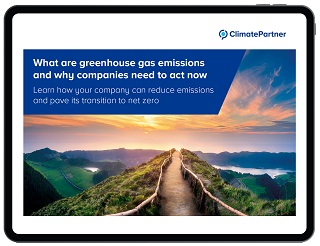Carbon footprint
Carbon footprint definition
A carbon footprint is the total set of greenhouse gas (GHG) emissions caused by an organisation or individual, or by a single event, service, or product. The emissions are calculated over a set period, generally a year (or the lifetime of an event or product), that can then be used as a baseline against which reduction efforts can be measured.
For simplicity of reporting, a carbon footprint is often expressed in terms of the amount of carbon dioxide (CO2) emitted, or the equivalent value of other GHGs (CO2e). Calculating a carbon footprint is more accurately described as estimating the emissions of the seven main GHGs named in the Kyoto Protocol, although CO2 represents around 80% of the overall warming effect of current emissions worldwide.
The term was inspired by the concept of an ecological footprint. It was first coined in the early 21st century in an advertising campaign as an attempt to shift the public’s focus towards personal responsibility. The term has remained in common use and now refers to corporate as well as individual climate impact.
Types of carbon footprints
The first personal carbon footprint calculator was released by BP in 2004, taking basic information about an individual’s home, transport, travel, and other emissions sources to calculate a value in annual tonnes of CO2e. Since then, there has been a push towards corporate climate responsibility, from which the idea of calculating product and corporate carbon footprints emerged.
A product carbon footprint refers to the emissions released over a product's life cycle, from raw material through the various stages of manufacturing, transportation, consumption, and recycling or disposal of the product. A corporate carbon footprint, on the other hand, indicates how many GHG emissions a company has caused over a certain time period, generally a year.
How to calculate a corporate carbon footprint
A corporate carbon footprint describes the total amount of GHG emissions that are caused by a company’s activities. The GHG Protocol Corporate Standard categorises these emissions into three scopes, referring to direct, indirect, and value chain emissions respectively.
When calculating a corporate carbon footprint, the three scopes are used as a framework to ensure that all emissions are accounted for, but that different companies aren’t counting the same emissions under the same scope. Scopes 1, 2, and 3 are only used when calculating the carbon footprint of a company, not for individuals or products.
How to reduce your carbon footprint
Reducing your personal carbon footprint can take many forms depending on the individual. Examples include flying less, using public transport or an electric car, and eating less meat and dairy.
To reduce a company’s emissions, a more coordinated effort is required. The first step is always to calculate the corporate and product carbon footprints and identify areas that can be reduced.
Calculating a corporate carbon footprint lays the foundation for a carbon management plan, giving clear insights into a company's GHG emissions across all three scopes, where any carbon hotspots lie, and what targets you can set to reduce your climate impact. Product carbon footprints, too, highlight areas where reduction efforts could be focused. Examples range from company-wide reductions in electricity consumption to changing the packaging materials of an individual product.
Any unabated emissions can then be offset by investing in certified carbon offset projects, to compensate for your remaining carbon footprint.
Learn more about calculating your corporate carbon footprint with the ClimatePartner Academy.
